In today’s competitive transport landscape, offering excellent service isn’t always enough to stand out. You might have the best fleet, the most courteous drivers, and a track record of punctuality—but if no one knows about it, your business won’t grow the way it could. This is where social media becomes a powerful tool, especially for transfer companies looking to reach more passengers, connect with partners, and strengthen their brand identity.
Social media isn’t just a place for big corporations or influencers. It’s an essential platform for small and medium-sized transport businesses too. Whether you’re targeting tourists, business travelers, or local groups, a strong online presence can help you stay visible, build trust, and attract the kinds of clients that lead to long-term growth.
In this article, we’ll explore how to use social media effectively to market your transfer service, from choosing the right platforms to creating content that drives bookings—and how a system like TransferVista can support your strategy behind the scenes.
Why Social Media Matters for Transfer Businesses
Let’s face it: people don’t plan their travel the same way they did ten years ago. Fewer travelers go straight to a traditional travel agency or call a taxi company directly. Instead, they turn to their phones. They search, browse, compare, and book—all within the apps and platforms they use every day.
That includes Facebook, Instagram, TikTok, and LinkedIn.
Having an active, well-maintained social media presence can serve multiple functions:
- It helps build brand recognition, especially among tourists and first-time visitors to your area.
- It gives your business a human face, showing the people behind the service.
- It allows you to communicate offers, updates, or changes quickly.
- It provides social proof through reviews, comments, and interactions.
- It gives you a platform to reach new partners, such as hotels and tour operators.
But more importantly, it helps you stay in the mind of potential customers when they’re ready to book. In a market where decisions are made quickly and visually, being part of someone’s digital feed is an opportunity you can’t afford to miss.
Choosing the Right Platforms
Not every social media platform works for every business. The key is to focus on the ones where your audience is already active.
Facebook remains one of the most useful platforms for local and regional transport businesses. With its ability to post long-form content, host reviews, and run targeted advertising, it’s ideal for connecting with customers planning trips in advance. Facebook Events can also be useful if your service includes group travel for local festivals, weddings, or tours.
Instagram is all about visuals, which makes it perfect for showing off your vehicles, scenic transfer routes, and happy customers. Many travelers use Instagram to plan where they’re going and how they’ll get there. A beautiful photo of a clean, air-conditioned van arriving on time at the beach or the airport can be surprisingly effective.
LinkedIn works well if your business focuses on corporate clients, hotel partnerships, or professional transport services. Sharing updates about your reliability, certifications, or fleet expansion helps position you as a serious, organized partner.
TikTok may not seem like a natural fit for transfer services, but it’s growing fast among younger travelers. Simple behind-the-scenes videos, day-in-the-life clips from drivers, or time-lapse shots of airport pickups can gain a lot of traction with the right hashtags.
What to Post: Content That Builds Trust
Many businesses hesitate to post on social media because they’re not sure what to say. The truth is, you don’t need to be flashy or overly creative—you just need to be authentic and consistent.
Here are some types of content that work particularly well for transfer services:
- Behind-the-scenes content: Show how your drivers prepare for the day, how vehicles are cleaned, or what goes into planning a smooth airport transfer.
- Client testimonials: If a family, couple, or group had a great experience, ask for a quick photo and permission to share their review.
- Service highlights: Explain what sets you apart. Do you offer child seats, multi-lingual drivers, or electric vehicles? Let your followers know.
- Seasonal updates: Use your feed to remind customers about summer travel tips, winter service availability, or upcoming holiday events.
- Team introductions: Help people connect with your business by showing the friendly faces behind the wheel or at the dispatch center.
If you’re using TransferVista, you already have a centralized system for tracking jobs, managing bookings, and sending confirmations. Use that data (anonymized, of course) to spot patterns—such as popular pickup times or most-used routes—and create content around them. For example, “Our 8 AM Heraklion Airport run is now fully booked for July—make sure to reserve early!”
This kind of real-time insight gives your social media posts more relevance and urgency.
Engaging with Your Audience
Social media is a two-way street. It’s not just about broadcasting your message—it’s also about listening and engaging.
When someone leaves a comment or asks a question, respond promptly. If someone tags your business in a photo or post, thank them or share it (with permission). Engagement helps build trust and boosts your visibility in platform algorithms, meaning more people see your content.
You should also encourage reviews. Happy passengers are often willing to leave a few kind words, especially if they had a smooth, comfortable ride. A short message like, “Thank you for traveling with us! We’d love to hear how your experience was. Feel free to leave a review on our Facebook page,” goes a long way.
Running Paid Campaigns
Organic content (unpaid posts) is essential, but for faster growth, consider investing in paid social media ads. These allow you to target specific groups, such as travelers arriving in your city next week or event planners searching for group transport.
Facebook and Instagram, in particular, offer very detailed targeting options. You can choose audiences based on location, language, travel habits, and even job title. If you’re offering transfers for a music festival, a major conference, or a seasonal tourism boom, a well-timed campaign can generate a steady stream of leads.
Create ads with clear calls to action. For example: “Book your summer transfer in Crete today!” or “Need airport pickup for your business clients? Reserve now.” Include a direct link to your booking portal—something TransferVista makes easy to manage through its web integrations.
Collaborating with Local Businesses
Social media isn’t just about reaching passengers directly—it’s also a tool for forming partnerships. By engaging with local hotels, tour providers, event venues, and restaurants on social platforms, you can build relationships that lead to referrals and shared promotions.
Consider posting content that tags or highlights your partners. For instance, a photo of your vehicle picking up guests from a popular beachfront resort—along with a thank you for the collaboration—helps both businesses.
In return, they might share your content with their followers, giving you access to a new audience that’s already interested in local travel experiences.
Staying Consistent
You don’t have to post every day, but consistency is key. Choose a posting schedule you can realistically stick to—once or twice a week is a good starting point. You can use free tools like Meta Business Suite or third-party apps to schedule posts in advance.
It’s also helpful to create a monthly content calendar. Plan posts around travel seasons, local events, or business milestones. For example:
- Week 1: Welcome summer travelers + airport tips
- Week 2: Behind-the-scenes look at vehicle cleaning process
- Week 3: Customer spotlight with quote
- Week 4: Collaboration with local winery tour
Using TransferVista’s data dashboard, you can also look back over previous months to see when bookings spiked—and align your posts accordingly.
Measuring Success
The beauty of social media is that it gives you real-time feedback. Most platforms offer insights into how your posts perform—how many people saw them, liked them, clicked, or commented. Over time, this helps you learn what kind of content works best.
Key things to track include:
- Follower growth
- Post engagement (likes, comments, shares)
- Website or booking portal clicks
- Message inquiries
- Customer reviews
If you’re using TransferVista, you can correlate spikes in booking activity with your campaigns to measure actual impact—not just engagement.
Using TransferVista’s Automated Messaging to Boost Reviews and Repeat Bookings
TransferVista also makes it easy to stay connected with customers through automated messaging. When a passenger books a transfer, the system can instantly send a confirmation message with all the details, reducing uncertainty and building trust.
After the trip, TransferVista can automatically follow up with a thank-you note and a request for a review, which not only helps you collect valuable feedback but also generates authentic testimonials you can share on social media.
You can even set reminders for repeat customers, encouraging them to book their next trip directly with you—turning one-time riders into loyal clients while steadily growing your online reputation.
Final Thoughts
Marketing your transfer service on social media isn’t just about showing off your fleet. It’s about telling your story, building relationships, and staying top-of-mind with the people most likely to need your services.
Done right, social media becomes more than a marketing tool—it becomes a driver of long-term growth. With a smart posting strategy, authentic content, and support from platforms like TransferVista to streamline operations and insights, your business can stand out in a crowded market.
Whether you’re based in a tourist hotspot like Crete or operating in a busy metropolitan area, there’s one constant: people are always looking for reliable, well-reviewed transport providers. Social media is your chance to show them why you’re the one to choose.


